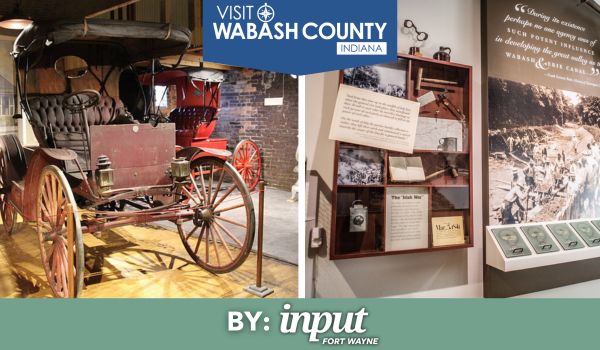North Manchester Native Thomas R. Marshall Served 2 Terms As US Vice President
By: Joe Slacian
The Wabash County town of North Manchester lays claim to being the home of former Vice President Thomas R. Marshall. Marshall, who served as vice president under President Woodrow Wilson, served one term as governor of Indiana before moving to the White House.
The son of Daniel and Martha Marshall, Thomas was born on March 14, 1854, the second of two Marshall children. An older sister, Susan Elizabeth, died in infancy in 1853.
Daniel Marshall moved to North Manchester in the early 1850s and was appointed as postmaster in 1853. The family moved from North Manchester in 1856, and headed for Rantoul, Illinois, after Martha Marshall developed a case of tuberculosis. Her husband felt the prairie air might be better for her. From there the family moved to Kansas, then LaGrange, Mo., eventually returning to Indiana in 1860. The family purchased property in Pierceton in 1862, and eight years later moved to Columbia City, where he practiced medicine until his death in 1892.
Thomas Marshall spent his formative years in Pierceton. While growing up, he attended high school in Warsaw and Fort Wayne, eventually being accepted at Wabash College in Crawfordsville, from where he graduated in 1873. After graduation, he began studying law under the tutelage of a Columbia City attorney and, in 1875, was appointed an attorney.

Marshall practiced law from 1876 until 1909. During this time, he became heavily involved with the Democratic Party. His popularity and name appeal in the state, largely gained by stumping for other Democratic candidates, led him to be elected Indiana’s 27th governor in 1909. His popularity among Democrats, and the fact that Indiana was considered by many to be a swing stated in the 1912 presidential election, Marshall was tabbed to be Wilson’s vice presidential candidate. He served in the position during both of Wilson’s terms in the White House.
Although he served in the position, Marshall wasn’t overly fond of the position. In fact, according to author Mark O. Hatfield in his book “Vice Presidents of the United States, 1789-1993”, Marshall claimed “that most of the ‘nameless, unremembered’ jobs assigned to him had been concocted essentially to keep vice presidents from doing any harm to their administrations.”
Marshall and Wilson had an ideological rift during the administration’s first term, eventually causing the president to move the vice president’s office off the White House grounds. In his book, Hatfield asserts that Marshall’s disdain for the position is largely found in his attitude toward attending Cabinet meetings. “Vice President Marshall stopped going after a single session,” Hatfield wrote. “When asked why, he replied that he realized ‘he would not be listened to and hence would be unable to make any contribution.’”
Many of Marshall’s comments throughout the years also proved his displeasure with the office. “I do not blame proud parents for wishing that their sons might be President of the United States,” he is quoted as saying. “But if I sought a blessing for a boy I would not pray that he became Vice President.” Marshall also is credited with saying, “Once there were two brothers: One ran away to sea, the other was elected vice president, and nothing was ever heard from either of them again.” Hatfield noted that even as President of the U.S. Senate, Marshall was of ten times overshadowed by Indiana’s two Democratic senators, Benjamin Shively and John Worth Corn.
During World War I, Marshall toured the country delving speeches bolstering the country’s war efforts. It was during this time that Marshall helped pass regulations — brought on by anti-war senators — to allow filibusters be ended by a two-thirds majority vote. A variation of the rule is still in place today.
Marshall could have assumed the presidency during his second term, when, in October 1919, President Wilson suffered an incapacitating stroke. Marshall was kept out of the loop by those close to Wilson, even refusing to keep him updated on the condition of the president. That, they believed, would prevent him from setting his sights on assuming the presidency.
Many urged Marshall to assume a role as acting president while Wilson recovered. However, the North Manchester native refused to do so, fearing it would create a precedent for future administrations. As Hatfield noted, “His years in Washington had convinced him that he desired the good will of others rather than the ‘pomp or power’ of the presidency. Rather than act as president, or even preside over cabinet meetings, Marshall contented himself with replacing Wilson as ‘official host’ for the many visiting European royalty and other dignitaries who came to Washington to offer thanks for American assistance during the First World War.”
Marshall was urged by many Washington insiders to run for the presidency in 1920 and again in 1924, but he declined to do so. Rather, he and his wife, Lois Irene, and their adopted daughter, Morrison “Izzy”, returned to Indiana.

Marshall died on June 1, 1925, and is buried at Crown Hill Cemetery in Indianapolis. Marshall’s boyhood home was located at 124 E. Main St., in North Manchester. It was moved to 102 E. Third St. in 1869 by Daniel Marshall’s brother, Milborn. It was moved again to 902 Walnut St. by Bart Krisher in 1905.
The North Manchester Historical Society purchased the home in 1992 and two years later moved it to its current location at 409 N. Market St. The refurbished home is open from 1-4 p.m. on the first Saturday of each month for tours.



